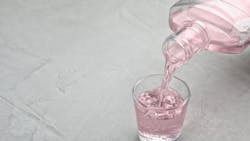Do you want that mouthwash straight up or on the rocks?
Intoxication isn't all it used to be
The Journal of Emergency Medicine reported that a 55-year-old woman arrived in an ER with acute ethanol intoxication. Medical personnel were puzzled because her serum ethanol levels were persistently elevated. They later discovered she was secretly quaffing mouthwash from her personal hygiene product stash in her purse while under their care.
Two teenagers in Troy, Michigan, reportedly drank mouthwash after seeing videos of people doing it on YouTube. Some of the teens' friends alerted authorities after they saw the pair become extremely ill, and they took them to an ER. When the local poison control center was contacted, someone at the center was quoted as reporting, "Drinking mouthwash is a common teen problem."
The Journal of Intensive Care Medicine reported in 2003 of a 45-year-old male who entered a Los Angeles Veterans Administration hospital and soon died of acute ethanol consumption due to "massive mouthwash ingestion."
A British ethanol "connoisseur" offered this mouthwash endorsement on the web: "Been drinking [popular consumer mouthwash] on the streets for ages now, gets you mashed good and proper. Best bit, it's cheap and makes you smell great. With four different colours and flavours, you just can't get bored with it. Nothing beats going down to the park on a Friday night with a bottle of [mouthwash] and getting mashed with your mates. It even comes with that cap that doubles as a shot glass. My favourite thought is [mouthwash] on the rocks. You can't beat that, and add an umbrella and you're south of the border."
While most cases of acute ethanol intoxication follow a binge with conventional alcoholic beverages, ethanol can also be easily obtained from a variety of commercial products. These products often contain high levels of ethyl alcohol but are not manufactured for drinking or ingestion. Called nonbeverage ethanol (NBE), these products are unorthodox definitions of a drinkable beverage—mouthwash, hair spray, hand sanitizer, cough and cold remedies, aftershave, and perfume, to name a few. The alcohol content of many of these products may exceed conventional alcoholic beverages by large margins.
For example, original formula Listerine is about 54 proof with 26.9% alcohol, and many of the mint flavored mouthwashes are almost 22% alcohol. The alcohol content of Scope weighs in at 18.9%, and Cepacol at 14%. When compared to beer (3% to 7% alcohol), wine (12%), and even some liquors and distilled spirits, these products are concentrated sources of ethanol. Experts claim it is possible if not probable that swishing with alcohol-containing mouthwash can trigger a positive Breathalyzer test result for seven to 20 minutes after use.
If alcohol in mouthwash were the standard, it would be subject to the federal excise tax that is levied by the government on all alcoholic beverages. Instead, the manufacturer modifies the ethanol in mouthwash into a "specially denatured alcohol," or SDA. Basically this means the company adds other chemical ingredients designed to make the product "undrinkable," but this doesn't deactivate the effects of the ethanol if ingested. For example, Listerine's form of SDA is proprietary, but the label says it contains eucalyptol, menthol, thymol, and methyl salicylate (oil of wintergreen), all deliberately added to discourage ingestion. Apparently this does little to deter an alcoholic's search for an ethanol source when conventional alcoholic beverages are unavailable. Even the strong, medicinal taste doesn't stop an alcoholic.
It may seem unbelievable that anyone would drink mouthwash, hand sanitizer, or hair spray. Unfortunately it's not unusual to read reports of alcoholics going to any lengths to "feed the need." Purchasing personal care products containing alcohol is socially acceptable and allows an alcoholic to secretly consume and have access to alcohol 24/7. It's cheap and easy to sneak products into shelters, it can easily be purchased by underage youths, and it is easy to conceal use from family and friends. Many of these products are reportedly shoplifted from stores due to the relatively small package size. Stores in Alaska moved the mouthwash and vanilla extract behind the counters to thwart theft of the products from nonpaying ethanol seekers.
The Internet is rampant with accounts of alcoholics triumphantly leaving rehab who relapse by swallowing mouthwash. "A highly functioning alcoholic wouldn't buy alcohol outright because it means the person relapsed," writes one recovering alcoholic on a blog. "But it's normal to buy mouthwash, and it's easy to hide. Besides, who would admit to being so desperate they'd drink mouthwash to get a buzz?"
But isn't drinking mouthwash poisonous? The warnings on the labels state, "Warning: Keep out of reach of children. If more than used for rinsing is accidently swallowed, get medical help or contact a poison control center right away." It may sound like a stern warning, but only to a nonalcoholic. Drinking mouthwash is openly discussed and even joked about on substance abuse forums, YouTube, AA meetings, and rehab clinics.
There are many examples in medical literature of extreme mouthwash intoxication that lead to multiple system failures and even death. Determining what other ingredients in mouthwash may be toxic in greater concentrations when someone drinks copious amounts has been recently studied. In January 2013, the Food and Chemical Toxicology Journal tested 30 brands of mouthwash containing ethanol to learn if any of the other ingredients were toxic and in what quantities. They discovered that even though some of the other ingredients exceeded "acceptable daily intakes," these were "inconsequential in their effects in comparison with the direct toxic effect of ethanol." Even ingesting 100g of ethanol in the form of mouthwash, the ethanol is the most toxic ingredient. They concluded, "The occasional or even chronic ingestion of mouthwash may not cause health effects except the effects of ethanol alone. Only in extreme exposures, ingredients such as thymol or methyl salicylate could exacerbate the effects of ethanol, especially by contributing to metabolic acidosis."
Some denatured alcohol products contain added poisons such as methyl (wood) alcohol. In October 2013, one hand sanitizer sold in Canada used unlabeled methyl alcohol in its formula, and at least two people died from drinking it. There seems to be little awareness by the public that these alcohol-containing products are abused and can be toxic or fatal.
Medical studies of alcohol abusers indicate 10% to 15% ingested nonbeverage ethanol products, and half of the members of this group were regular consumers of NBE products. Ease of accessibility was the No. 1 reason for regular use. A study in New Mexico found blue laws, which restrict the sale of alcohol during early morning hours and on Sundays, were directly related to consumption of nonbeverage ethanol products during times when alcoholic beverage sales were restricted.
So why put alcohol in mouthwash at all? It is often the carrier for the flavor or other ingredients, provides a refreshing "bite," and contributes an antibacterial effect. It's also drying, causes tissue sloughing and burns, alters taste, and leads to stains and mouth ulcers. Most mouthwash manufacturers do make an alcohol-free version, but many consumers feel it isn't as effective without the burn and tingle that proves the product "is working."
It's hard to say if manufacturers of alcohol mouthwash are aware of the abuse problem associated with their products. Will removing the ethanol from mouthwash make any real difference in stopping an alcoholic or teen drinker? That is difficult to speculate. An alcoholic is sick and alcoholism is a disease. But making it easy to imbibe by purchasing personal care products, and being able to successfully hide the behavior behind a minty fresh mask is also a problem.
"The thing is, if an alcoholic wants to drink, there is absolutely nothing on God's green Earth that's going to prevent the behavior short of chaining them up and chucking them in the basement," said a man identified as Weaver on an Internet blog. "The alcoholic must accept life on life's terms! The next thing you're going to ban is fruit and bread and sugar because that can make jail juice. There are more ways for a drunk to get drunk than Varter has liver pills, and there are even more ways to alter one's state of conscience, so it really does come down to personal accountability. I know it's a bitter pill, but seriously, it is not [a dental manufacturer's] fault or problem."
Awareness and education can help patients select the products that are right for their circumstances. A wise choice in our purchasing, use, and storage of products is important and requires some consideration in light of its possibility for abuse.
Ethanol vs. Methanol vs. Isopropyl Alcohol
There are many forms of alcohol. These alcohol substances look and sound similar but have some important differences, and mistaking one for another can be fatal. All of these alcohols are colorless, flammable, and used in solvents and fuels.
Ethanol (C2H6O) or ethyl alcohol is produced by yeast and is found in alcoholic beverages. It burns with a blue flame and is safe to consume in moderate amounts. Ethanol (E85) for automobile fuel is ethanol that has been further distilled. Denatured alcohol sold at drugstores is also ethanol but has additives to make it poisonous.
Methanol (CH4O), also known as wood alcohol, is toxic and should never be ingested, inhaled, or come in contact with skin. Methyl alcohol burns with a bright yellow flame. Methanol is often found in windshield wiper fluid and is made from natural gas.
Isopropyl alcohol (C3H8O), or rubbing alcohol, is not as poisonous as methanol but is also toxic if ingested, inhaled, or topically absorbed. It metabolizes into acetone in the body, and 15g can be toxic for a person of average weight.
References
http://www.ncbi.nlm.nih.gov/pubmed/23041419
http://www.ncbi.nlm.nih.gov/pubmed/14984634
http://webcache.googleusercontent.com/search?q=cache:s02BLKSNLRwJ:ask.metafilter.com/45110/Is-there-a-delicious-premixed-cocktail-in-my-bathroom-closet+&cd=4&hl=en&ct=clnk&gl=us
http://alcoholrehab.com/alcohol-rehab/recovering-alcoholics-and-mouthwash/
http://ethicsalarms.com/2010/04/14/the-amazing-mouthwash-deception-helping-alcoholics-relapse-for-profit/
http://www.cbc.ca/news/canada/toronto/hand-sanitizer-ingestion-linked-to-2-ontario-deaths-1.2252046
Cathleen Terhune Alty, RDH, is based in King George, Va.
Originally posted in 2014 and updated regularly
About the Author

Cathleen Terhune Alty, BA, RDH
Cathleen Terhune Alty, BA, RDH, is a graduate of The Ohio State University. In the dental field for nearly 40 years, she is a prolific award-winning dental writer with over 300 published articles. Alty has also worked as a practice consultant and CE conference speaker. She presently works as a clinical dental hygienist at a Navy base in Virginia.
